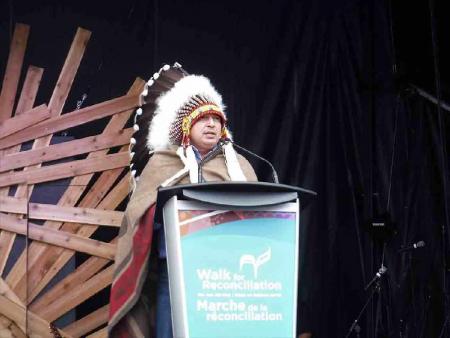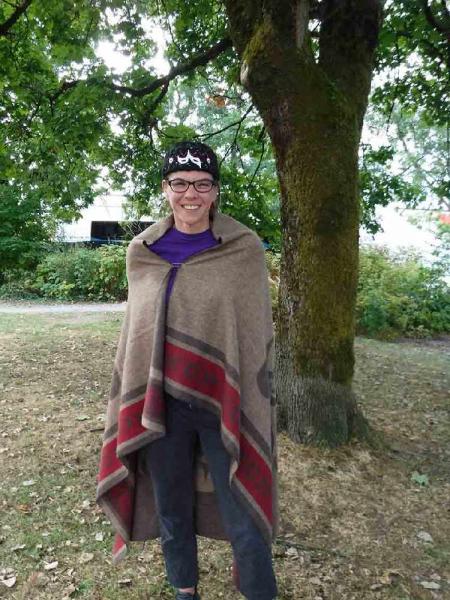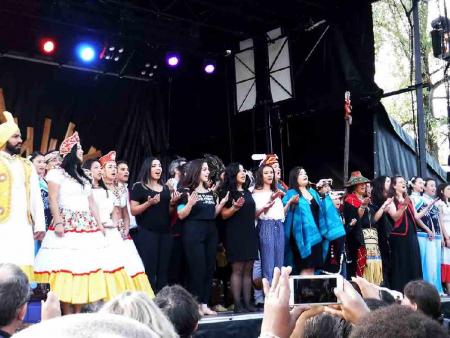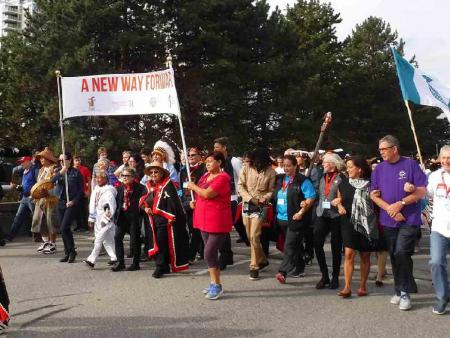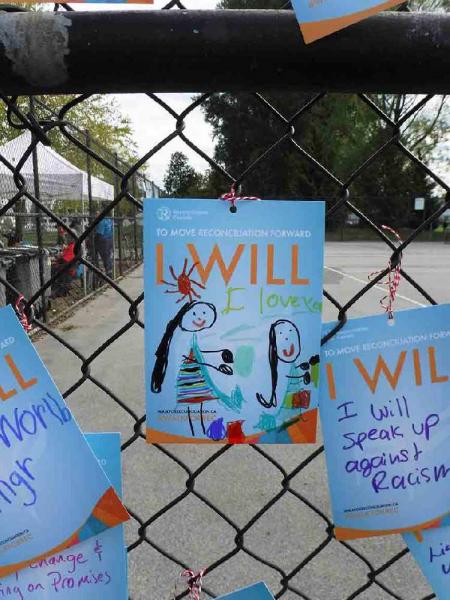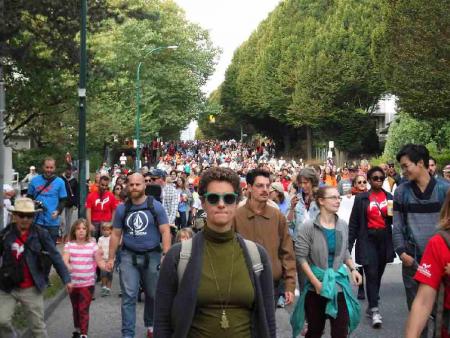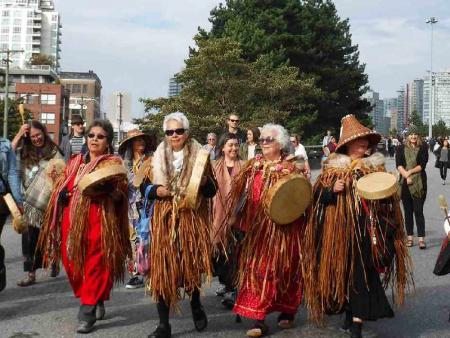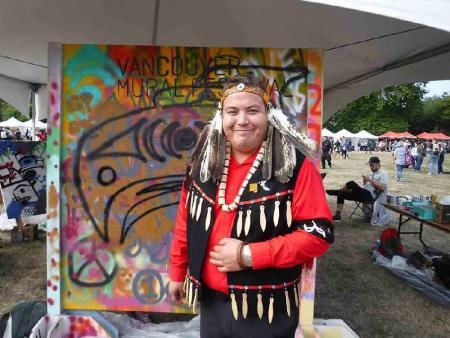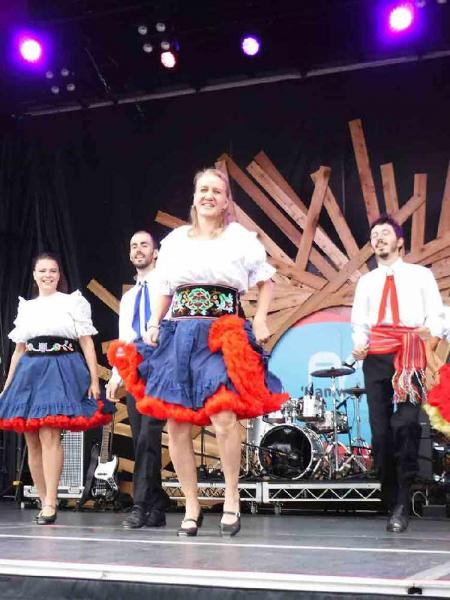Image Caption
Summary
{ALBUM_998718}
By Andrea Smith
Windspeaker.com Contributor
VANCOUVER
“No one here in Canada may have had a direct hand in the dark chapter of our history…. Maybe no one here today had a connection to the residential schools, or even the Indian Act…, but you can all still play an important role in building our future.”
Perry Bellegarde, national chief of the Assembly of First Nations, shared his advice on “reconciliation” as he spoke to a crowd of hundreds of people gathered in front of the stage he stood on. Everyone had come together for the two kilometer Walk for Reconciliation hosted by the city of Vancouver on the morning of Sunday Sept. 24.
“When we walk to honor this word ‘reconciliation’… When we join together to honor past generations… When we remember those who perished and never made it home from residential schools… And when we honor those who survive and lift them up… We are working together to build a stronger First Nation, and a stronger future,” he said. And as he finished his speech, the crowd cheered.
The walk kicked off at 9:30 a.m. at the crossing of Cambie and Georgia. And it ended in Strathcona Park, where an expo was set up with activity tents, an artisan market, food trucks, and a stage for speakers and performers to grace throughout the day.
Minister of Justice and Attorney General Jody Wilson-Raybould, along with B.C Minister of Indigenous Relations and Reconciliation Scott Fraser, John Horgan, premier of British Columbia, the Mayor of Vancouver Gregor Robertson, ambassador of Reconciliation Canada Chief Robert Joseph, CEO of Reconciliation Canada Karen Joseph, Councillor Chris Lewis and Chief Ian Campbell of the Squamish Nation, Chief Wayne Sparrow of the Musqueam Nation, and councillor Liana Martin from the Tsleil-Waututh Nation were other speakers at the event.
Performers Susan Aglukark, Tsatsu Stalkaya (Coastal Wolfpack), the Eagle Song Dancers, George Leach, Axe Apoiera (dancers), the Lorita Leung Dance Academy, Emmanuel Jal, and Sister Says made appearances throughout the day.
Charlene Seward works with Reconciliation Canada, and had a hand in organizing the walk along with her team of 15 people. The main goal of the walk, and the expo that followed, was to bring Indigenous and non-Indigenous people together to decide for themselves what reconciliation can, and should, look like.
“The Walk for Reconciliation is like a memorable one-day event to inspire and build commitment and action towards reconciliation. Our goal is to engage all Canadians. It’s not just for the Indigenous Canadians. It’s based on our belief we need everyone in reconciliation movements,” said Seward.
She (and her colleagues) estimated the walk would only take about an hour to complete, a walk which would take about 20-minutes if a person alone would do it.
But with the tens of thousands of people who showed up to march, an hour-and-a-half later, walkers were still flooding across the Strathcona Park finish line.
“This event is held in partnership with Reconciliation Canada, and the City of Vancouver, with funding from Heritage Canada, as well as our various sponsors…. We have Spark in, doing lacrosse and we have Right To Play helping, too,” said Seward. “And we have our ‘Commitment Corner’… We’re asking people to write down their commitment to reconciliation, ensuring this is work people really internalize and really take on in their personal lives,” she added.
Andrea Reimer, a Vancouver city councillor, also participated in the walk. For her, reconciliation is an ongoing process, and she’s dedicated much of her life to this exact cause. While hopeful about the response to the walk, she still feels more progress needs be made.
“It’s not just about dialogue… It’s about actually taking that action on…. There’s a big pile of trauma that resulted from colonization and it still plays out every day in the city of Vancouver. And sometimes it’s hard to find the energy to keep fighting this every day…” she said, choking up with tears.
“But this matters, right? It gives energy to that work,” she said, adding she believes First Nations people should be consulted every step of the way when it comes to any government actions.
Marlene Erickson, director of Aboriginal Education at New Caledonia College in Prince George, made a special trip down to Vancouver to participate in the walk. Tied to the front of her shirt was a picture of her mother, who attended the Lejac Indian Residential School in Fort St. James. Erickson’s mother passed away at the age of 53, before any of the reconciliation efforts ever came forward.
“She passed away when she was quite young… before Indian women were given back their status, before people started talking openly about the residential school experience, and before the Prime Minister apologized… And to me, I always feel a sense of regret… I always think that if only my mom…,” Erickson said, her voice cracking from emotion. “It would help to heal her spirit and her experience, and she’d still be with us... I walk for her today.”
Gallery
Windspeaker.com is owned and operated by the Aboriginal Multi-Media Society of Alberta, an Aboriginal communications society dedicated to serving the news and information needs of Aboriginal people throughout Canada.
Incorporated in 1983 under the Alberta Societies Act, the Aboriginal Multi-Media Society has steadfastly maintained its commitment to the quality of its products and its people.
AMMSA has served as the model for Aboriginal communications societies and organizations and has provided training, support, and encouragement to other Aboriginal groups, communities, and societies wishing to establish their own communications facilities.
Our Mission:
The Aboriginal Multi-Media Society is an independent Aboriginal communications organization committed to facilitating the exchange of information reflecting Aboriginal culture to a growing and diverse audience.
AMMSA is dedicated to providing objective, mature and balanced coverage of news, information and entertainment relevant to Aboriginal issues and peoples while maintaining profound respect for the values, principles and traditions of Aboriginal people.
Organizational History
1983
A monthly publication was first published in 1983, Windspeaker was intended to serve the Aboriginal people of northern Alberta. In the years that followed, Windspeaker expanded and developed its circulation base and readership to the point where in 1993, on its 10th anniversary, it refocused its editorial coverage and repositioned itself to become Canada's first and only provider of national Aboriginal news, information and opinion. It was a tremendous leap of faith and required a substantial shift in strategy and a major realignment of critical resources.
1990
With a 100 per cent cut in federal funding in 1990, nine of the 11 Aboriginal publications across Canada included in the now defunct Native Communications Program closed their doors. Windspeaker was the only publication west of Ontario to survive the federal cuts and was challenged to fill the void created by the demise of these other publications.
1993
"This was an excellent window of opportunity for us, and Windspeaker took up the challenge. Our goal was to provide news, information and views from a national perspective in a way that would complement the work of other Aboriginal media, which typically served a much more local community," said Bert Crowfoot, Windspeaker publisher.
"Back in 1993 we put our faith in our staff to transform Windspeaker into a national forum that would be supported by readers through subscriptions and, in time, by advertisers. "
The formula has worked very well. After years of cost-cutting with the elimination of government funding, AMMSA and Windspeaker are underwent expansion and growth.
"One of our organization's philosophies is to turn stumbling blocks into stepping stones. We saw the elimination of government funding, both provincial and federal, as a wake-up call to pursue the dream of having an Aboriginal publication that was both financially and politically independent. We focused on developing a product that would attract a loyal readership," said Crowfoot.
1996
AMMSA launches debuts its first website property: www.ammsa.com
2000
AMMSA digitizes all of the published articles in Windspeaker and its publication Alberta Sweetgrass, launched in December 1993, dating back to 1983 and makes them available online as part of a archive of 20,000+ news and information articles.
AMMSA also owns and operates CFWE-FM radio, Alberta's first and most extensive Aboriginal broadcaster.
Currently serving 54 Alberta Aboriginal communities via satellite, an extensive and ambitious expansion plan has been developed to broadcast CFWE throughout southern Alberta.
As we continue to increase the signal coverage area, our plan is to include every First Nation and Métis Settlement in Alberta.
2009
CFWE radio launches in urban centres: Edmonton and Fort McMurray.
The Future
Not an organization to shy away from new technology, AMMSA has also developed comprehensive web site properties to showcase its various services, publications, news and entertainment online, including Windspeaker.com and cfweradio.ca


